
Minggu, 31 Agustus 2008
Worth $ 139000 USD Flying Car 2010 Will Be Listed In The USA
See below the car, what is your feeling ? F15 is not like the way the wings rolled up ? Designers called Icon A5, 2010 debut in
Kia Soul

 |  |  |
CR's take: The Soul provides another choice for consumers looking for a versatile small car. But it’s too bad Kia won’t initially be offering it in North America with the more fuel-efficient diesel engine that will be available elsewhere.
New Car: 2010 Cadillac CTS Sport Wagon

Cadillac's renaissance takes another step forward with the 2010 CTS Sport Wagon. The latest addition to the CTS range is all about prestige and presence -- and attracting more customers in European markets. Introduced this weekend at the Pebble Beach Concours d'Elegance, the new wagon will roll into Cadillac dealerships in spring 2009.
Not surprisingly, the CTS Sport Wagon powertrains are identical those of the sedan. A 3.6L 263 hp V-6 sits as the base engine in the U.S. with the direct-injection 3.6L V-6 making 304 hp as the top engine. As on the sedan, potential wagon buyers must choose between an Aisin six-speed manual or six-speed automatic, and between rear and all-wheel drive. With EPA highway ratings expected to be in the mid-twenties, the wagon should garner a few more MPG overall than bigger crossovers.
General Motors says a 2.9L turbodiesel is being prepared largely for European and Asian markets, although 250-hp engine will not be an option on the CTS Sport Wagon when it launches. No word yet on whether we'll see a diesel option in the U.S. at some point, but don't count on it.
While the wagon's front-end styling is carried over from the four-door CTS, there is plenty of new glass and sheetmetal out back, including thick D-pillars and large vertical taillights that flank both sides of the power lift-gate.
In an effort to better integrate the roof management system into the design, the chrome bars stretching to the rear of the car are set right against the roofline and GM says the system allows for an unobtrusive placement of the cross bars. Whether it's form over function remains to be seen. The bars meet the top of the taillights, which extend just a bit beyond the rear windshield, creating a small visual homage to finned Cadillacs of the past.
"They're not fins in the classic sense," says Clay Dean, Cadillac's global design director, "but they work to help disguise the cargo load system and, yes, they acknowledge Cadillac's design heritage."
New Car: 2010 Bugatti Veyron Grand Sport

Bugatti has confirmed that it will build 150 of the new Veyron Grand Sports after the open-top version of the world's fastest car was launched at the Pebble Beach Concours.
Rumours of an open-topped Veyron had been around since the car's introduction, but the Grand Sport was only confirmed for production last year. It will take total Veyron production up to 450 cars by 2011, breaking the company's earlier commitment to build no more than 300 Veyrons.
Like the Veyron 16.4 coupe, the Grand Sport is all about superlatives. Its top speed remains unchanged at 253mph, but the bodywork has been revised to allow high-speed driving with the roof down.
The biggest single difference is that the roof has been set higher to reduce wind intrusion into the cabin, with substantial reinforcement to the Veyron's inner structure to compensate for the structural loss of the open roof. Sills and transmission tunnel have all been beefed up, while the B-pillars are braced with a new carbonfibre strut, and the carbonfibre doors have been strengthened with a side impact bar.
For roll-over protection, the Veyron coupe’s distinctive air intakes are re-designed to include 100mm wide carbon-fibre tubes to protect occupants. Although it’s capable of more, Bugatti advise the drop-top Veyron isn’t taken over 233mph. It will cost a cool £1.14 million before taxes - around £150k more than a Veyron. (Thanks to Autocar for News and Pictures).
Honda Fit

 |  |  |
The wheel sizes have increased to 15 and 16 inches.
Standard safety equipment includes anti-lock brakes, side and side-
curtain air bags, and active head restraints. Electronic stability control
is available.
What is new or notable? Significant in this class, the Fit will offer an
in-dash navigation system with 6.5-inch screen and voice recognition, tilt/
telescope steering wheel, and USB audio input.
When will it be available? Fall 2008.
Rabu, 27 Agustus 2008
All-new 2010 Cadillac SRX becomes smaller

The 2010 Cadillac SRX has been revealed, alongside the CTS sport-wagon. While the older SRX was based on the larger rear-driven CTS platform, the new SRX will be based on a smaller front-driven platform to be shared with the upcoming Saab 9-4X.

The new model is based on the Provoq concept, and was originally supposed to slot in under the existing midsize SRX with a BRX badge. But will falling SUV sales everywhere (except in the GCC of course), GM decided to make the SRX a smaller fuel-efficient vehicle.

So far, only photos have been released, but it is known that front-wheel-drive and all-wheel-drive versions will be available, utilising V6 engines shared with the CTS. It is a given that the new SRX will come to GCC markets.
Confused 2009 Renault Safrane hits GCC

One of our readers, Mohamad, pointed us to this thread on nissan-arabia.com, showing local photos of the GCC-spec Renault “mystery sedan” that we exposed some time ago. It looks like the new sedan will revive the Renault Safrane nameplate for this Japanese-designed Korean-built French-badged car.

The original Renault Safrane from the 1990s was a weird midsize car with a liftback body that never caught on in the GCC, and quietly disappeared even in Europe. As reported earlier, this new model is a rebadged version of the Korean-market Samsung SM5, which itself is a facelifted version of the Japanese-market Nissan Teana, which again is based on the Nissan Altima platform.

It looks like the “new” Renault Safrane will only be available in the GCC, with a 170-hp 2.3-litre V6 mated to a front-driven platform and automatic gearbox, and outfitted with entry-level luxury equipment.
Selasa, 26 Agustus 2008
2009 Toyota Corolla Preview
 Critical Knowledge:
Critical Knowledge:- All-new, 10th-generation model
- New exterior and interior design
- All-new chassis and suspension
- Newly-designed instrument display
- New 3-spoke steering wheel with available audio and Bluetooth controls
- Lower, wider and longer than previous generation
- Five grades to choose from: Standard, LE, XLE, S and XRS
- Five new exterior colors
- Arrives at dealerships in February, 2008
Introduction
On sale continuously in the U.S. since 1968, the Toyota Corolla has sold more than 30 million units worldwide since its introduction in Japan in 1966. The Corolla has been the best-selling car in Japan for most of that time, and for the past 20 years, has been the second best-selling model in Toyota’s North American lineup. In summary, the Corolla is the world’s all-time best-selling passenger car. With the introduction of the all-new, 10th-generation Corolla for the 2009 model year, Toyota hopes to maintain and build upon that success.
 The Corolla is positioned between the entry-level Yaris and the Camry in Toyota’s U.S. lineup. For this latest generation, and in an attempt to attract younger buyers to feed the brand, Toyota focused on creating a more emotional connection with a more diverse audience than for previous Corolla models. Toyota focused on two areas: creative style and packaging, and improvements in sensitivity performance. Rather than designing and engineering the new model to appeal to buyers in one regional market, a broader approach was taken. Handling performance, for example, was calculated to meet the rigorous requirements of European highways, such as Germany’s Autobahn. Other aspects, such as ride comfort, roominess, cargo capacity and functionality, were based on the demands of the U.S. market, Corolla’s largest in terms of sales.
The Corolla is positioned between the entry-level Yaris and the Camry in Toyota’s U.S. lineup. For this latest generation, and in an attempt to attract younger buyers to feed the brand, Toyota focused on creating a more emotional connection with a more diverse audience than for previous Corolla models. Toyota focused on two areas: creative style and packaging, and improvements in sensitivity performance. Rather than designing and engineering the new model to appeal to buyers in one regional market, a broader approach was taken. Handling performance, for example, was calculated to meet the rigorous requirements of European highways, such as Germany’s Autobahn. Other aspects, such as ride comfort, roominess, cargo capacity and functionality, were based on the demands of the U.S. market, Corolla’s largest in terms of sales.
Model Lineup
The 2009 Toyota Corolla will be offered in five grades: Standard, LE, XLE, S and XRS. Standard models come with a 1.8-liter, 4-cylinder engine; 15-inch steel wheels; rear window defogger; air conditioning; intermittent windshield wipers; two 12-volt power outlets, daytime running lights; folding power mirrors; anti-lock brakes; power steering; tilt/telescoping steering wheel; and a 4-speaker, satellite-ready, AM/FM/CD audio system with auxiliary input jack and MP3 playback capability.  LE models add power windows with one-touch driver’s down feature, shift-activated power door locks, and color-keyed manual-folding power side mirrors. XLE trim adds 16-inch steel wheels, variable intermittent wipers, remote keyless entry, Toyota’s Optitron gauges, center console with sliding armrests, 6-speaker AM/FM/CD audio system, and woodgrain interior. In addition to Standard model equipment, the sporty S models add 16-inch wheels; a body kit including a front spoiler, rocker moldings, and upper and lower rear spoilers; fog lamps; front sport seats; leather-wrapped steering wheel; chrome exhaust tip; and the 6-speaker audio system.
LE models add power windows with one-touch driver’s down feature, shift-activated power door locks, and color-keyed manual-folding power side mirrors. XLE trim adds 16-inch steel wheels, variable intermittent wipers, remote keyless entry, Toyota’s Optitron gauges, center console with sliding armrests, 6-speaker AM/FM/CD audio system, and woodgrain interior. In addition to Standard model equipment, the sporty S models add 16-inch wheels; a body kit including a front spoiler, rocker moldings, and upper and lower rear spoilers; fog lamps; front sport seats; leather-wrapped steering wheel; chrome exhaust tip; and the 6-speaker audio system.
The performance-oriented XRS model offers a 158-hp, 2.4-liter engine, P215/45R17 tires on 17-inch aluminum wheels, and standard vehicle stability control and traction control. It further differentiates itself by offering sport seats, a leather-trimmed shift knob, door sill scuff plates, a tailpipe finisher with diffuser, rear spoiler, and black color-keyed headlamps.  In addition, the XRS offers 4-wheel disc brakes, a sport strut tower brace, and grade-specific electronic power steering system tuned for better road feel, according to Toyota. In tests conducted by Toyota, the XRS achieved 0 to 60 mph in less than nine seconds.
In addition, the XRS offers 4-wheel disc brakes, a sport strut tower brace, and grade-specific electronic power steering system tuned for better road feel, according to Toyota. In tests conducted by Toyota, the XRS achieved 0 to 60 mph in less than nine seconds.
Optional equipment on Standard models includes cruise control, a 6-disc CD changer audio system, satellite radio and 6 speakers, a power package that includes power windows and locks, and an All Weather Guard package. LE models can be equipped with 16-inch aluminum wheels and keyless entry. XLE models can be outfitted with a moonroof, stability control and traction control, and 16-inch alloy wheels. Leather upholstery is available on S and XRS models. A 6-speaker, AM/FM/6-disc CD changer audio system is available on all models. In addition, a JBL 8-speaker, AM/FM/6-disc CD changer audio system with Bluetooth capability is available on S, XLE and XRS grades. Also available on S, XLE and XRS grades is a new, entry-level navigation system with 7-inch LCD and more than eight million pre-programmed points of interest.
Hardware
The base engine in the 2009 Toyota Corolla is a 1.8-liter, DOHC, 16-valve, 4-cylinder unit featuring dual independent variable valve timing with intelligence (VVT-i) technology, the first such application in a Toyota model. The engine is standard on all but the high-performance XRS models.  Output is 132 hp @ 6000 rpm, and 128 lb.-ft. of torque @ 4400 rpm. It runs on 87 octane unleaded fuel. EPA estimated fuel economy is 27 mpg city/35 mpg highway when coupled to either the electronically controlled 4-speed automatic or 5-speed manual transmission.
Output is 132 hp @ 6000 rpm, and 128 lb.-ft. of torque @ 4400 rpm. It runs on 87 octane unleaded fuel. EPA estimated fuel economy is 27 mpg city/35 mpg highway when coupled to either the electronically controlled 4-speed automatic or 5-speed manual transmission.
Standard on XRS models is a larger, more powerful 2.4-liter 4-cylinder unit that also features DOHC and VVT-I engine technology. It produces 158 hp @ 6000 rpm and 162 lb.-ft. of torque @ 4000 rpm. It is available with either a performance-oriented 5-speed manual or 5-speed electronically controlled automatic transmission. EPA estimated fuel economy for the XRS is 22 mpg city/30 mpg highway when coupled with the 5-speed automatic transmission, and 22 mpg city/29 mpg highway with the 5-speed manual transmission.
A newly developed suspension ensures excellent noise, vibration and harshness performance while achieving both good handling stability and ride comfort, according to Toyota. All 2009 Toyota Corolla models feature front ventilated disc brakes. All but the XRS have rear drum brakes. Electric power steering is standard.
Design
When designing the new 2009 Corolla, Toyota changed its design approach, going from individual styling for individual markets to a unified global design. For inspiration, design engineers and stylists moved to Turin, Italy for four months. The result: a more youthful and sporty style, far more European, according to the company. The new design, Toyota says, “conveys an image of strength, solidarity and stability, requiring a larger frame and a completely reworked package.”
The new design is wide and low; overall width has been increased by 2.4 inches, and overall height reduced by 0.8 inches. Overall length increased by 0.4 inches, while the wheelbase remains the same at 102.4 inches. Overall passenger volume increased by 1.7 cubic feet.
 To create a lower, sportier shape, the bottom of the A-pillar was moved forward while the bottom of the C-pillar was moved rearward, increasing the angle of the window glass and achieving a sportier shape. The instrument panel was lowered to increase forward visibility, and the new design features a nearly flat rear floor. To maximize passenger seating comfort, both front and rear seats have extended seat cushions.
To create a lower, sportier shape, the bottom of the A-pillar was moved forward while the bottom of the C-pillar was moved rearward, increasing the angle of the window glass and achieving a sportier shape. The instrument panel was lowered to increase forward visibility, and the new design features a nearly flat rear floor. To maximize passenger seating comfort, both front and rear seats have extended seat cushions.
Safety
All 2009 Toyota Corolla models come equipped with dual-stage front air bags with driver position sensor and front-passenger occupant classification system, driver and front passenger seat-mounted side-impact air bags, and front and rear side curtain air bags. Anti-lock brakes with electronic brake-force distribution and brake assist are standard on all 2009 Corolla models, as are a tire-pressure-monitoring system, front seat belts with pre-tensioners and force limiters, and active headrests for front-seat occupants. Stability control and traction control are standard on XRS models and available on all other models.—Jeff Youngs
2011 Chevrolet Cruze Preview
 Critical Knowledge:
Critical Knowledge:- All-new entry in compact segment
- Developed by global design and engineering team
- Will be built in multiple locations
- Three engines: 1.6- and 1.8-liter VVT, and new 2.0-liter turbo-diesel
- 5-speed manual and all-new 6-speed automatic transmissions offered
- On sale in European markets in Spring 2009; other global regions to follow
See 2011 Chevrolet Cruze Pictures
Introduction
Chevrolet picked the Paris Motor Show for the worldwide premiere of its all-new compact sedan, the Cruze, which will go on sale first in Europe in March 2009. Why Europe? Chevrolet is GM Europe’s fastest-growing mainstream brand, with European sales up 23 percent in the first six months of 2008. The division expects the Cruze rollout to generate even more sales success in Europe, and create a buzz that carries over into other global markets as the car is introduced there with regionally-specific engine choices. As for North America, Cruze will be the replacement for the Chevy Cobalt, and will be a 2011 model. Cruze fits in the Chevrolet model lineup between the subcompact Aveo and the midsize Malibu.
 Design
Design
Developed by a global design and engineering team, the design of the Cruze is meant to be bold, not evolutionary, according to the all-new compact car’s Chief Designer, Taewan Kim. The car’s arching roof-line extends from a windshield with steep rake to rear pillars that slope to the back and a short rear deck, creating a compact sedan that looks like a well-proportioned coupé.
The car is longer (at 4.6 meters, or 181.1 inches) and wider than a majority of the competition, and will have plenty of space inside for 5 passengers and cargo. Chevy says the Cruze’s fit and finish for gaps and interfaces sets a new standard in the segment, not only in Europe, but around the world.
Hardware
By the European launch time, the Chevrolet Cruze will be available with three 4-cylinder engines: two gasoline engines and one diesel. Both the 16-valve, 1.6-liter engine with Variable Valve Timing (VVT) on both inlet and exhaust sides that produces 112 hp, and the 1.8-liter VVT engine delivering 140 hp, will help reduce emissions, the maker says. Chevy will also offer a new 2.0-liter turbo-diesel engine that develops 150 hp for even more power and fuel economy.
The Cruze engines will be mated to 5-speed manual transmissions as well as an all-new automatic transmission—the first 6-speed automatic transmission in the compact segment, according to Chevy.
Safety
Chevrolet designed the all-new Cruze as the first in its new family of compact products that the division promises “will deliver world class quality, backed by expected highest scores in all major crash safety ratings.” That means a target of perfect 5 stars in the National Highway Traffic Safety Administration (NHTSA) in all frontal, side-impact and rollover tests, as well as “Good” scores from the Insurance Institute for Highway Safety (IIHS) in frontal, side-impact, rear crash protection and head restraint ratings.  Safety features on the 2011 Chevrolet Cruze include electronic stability and traction control, tire-pressure monitor, advanced dual-stage frontal air bags and GM passenger sensing system, 4-wheel anti-lock brakes (ABS) and standard or optional additional safety technologies.
Safety features on the 2011 Chevrolet Cruze include electronic stability and traction control, tire-pressure monitor, advanced dual-stage frontal air bags and GM passenger sensing system, 4-wheel anti-lock brakes (ABS) and standard or optional additional safety technologies.
Technology
When the 2011 Chevrolet Cruze debuts, expect standard OnStar 8.0, including GM Advanced Crash Response System, with available Turn-by-Turn Navigation and Destination Download, Bluetooth connectivity for hands-free calling, and standard XM satellite radio with new NavTraffic feature.—Suzanne Kane
Concept: Mercedes-Benz F 700 Research Car Preview
- Hints at next-generation S-Class
- Utilizes DIESOTTO drive system technologies
- Offers significantly increased fuel economy with low emissions
- Equipped with PRE-SCAN active suspension
- SERVO-HMI instruments improve ergonomics and ease driver load
- REVERSE seating offers a reconfigurable cabin interior
Introduction
The Frankfurt Motor Show gives us our first look at the Mercedes-Benz F 700 Research Car, a future large luxury-touring sedan from the European car manufacturer. The stylized 4-seat sedan may offer a glimpse at the next-generation S-Class—from the advanced exterior styling and innovative interior appointments, to the sophisticated powerplant technology. “Like each of the research cars which preceded it, the Mercedes-Benz F 700 provides inspiring ideas for the technological future,” according to Mercedes-Benz.

Presenting a sleek silhouette to the wind, the large 4-door features three conventionally hinged doors and one rear-hinged “coach” door, affording easier passenger access to the opulent cabin. The very long wheelbase on the F 700 concept allows for an abundance of interior space for the occupants. REVERSE seating, an interior approach that orients individual seating positions either forward or rearward facing, affords maximum spaciousness and supreme comfort.
The instrument panel utilizes the Mercedes “SERVO-HMI” concept. Displays are easy on the eyes, and the number of controls has been significantly reduced. The computer’s operating menu is simplified and more self-explanatory than current designs. In hands-free mode, a virtual-operating avatar-based assistant can “discuss” complicated inputs with the driver, such as the intended navigation destination.
 Hardware
Hardware
The exceptional fuel economy—notable for a vehicle of this size and class—is made possible by a “forward-looking” drive concept Mercedes-Benz calls “DIESOTTO.” This engineering approach offers the high power of a spark-ignition engine with the exemplary torque and renowned fuel economy of a diesel. By carefully controlling the auto ignition, and utilizing direct injection and turbocharging, the 4-cylinder powerplant of the F 700 attains the same performance levels found in existing Mercedes-Benz 3.5-liter V-6 gasoline engines.
Cabin noise and vibration levels are kept low with the active PRE-SCAN suspension system. With two laser scanners reading the road ahead of the vehicle, the hydraulically controlled active suspension proactively compensates for irregularities, helping to smooth the harshness and create what Mercedes calls a “flying carpet” ride.—Michael Harley
Minggu, 24 Agustus 2008
2008 Mazda MAZDA5 Review - Bringing the European “space wagon” to America
By Alex Kramer

Pros:
- Perfectly poised suspension
- Fantastic touch-screen Navigation system
- Practical dual sliding doors
- Unique, shuttle-style exterior design
Cons:
- Eager engine outmatched by chubby curb weight
- So-so build quality
- Cramped 3rd row seats
- Less than stellar fuel-efficiency
The automotive landscape is changing fast. Truck and SUV sales are down almost 30% from last year. Customers are clamoring for anything with a 4-cylnder engine and hybrids are flying off the shelves. Although gas prices have eased a bit as summer comes to a close, consumers seem to have adjusted to the reality of $4 a gallon, leaving car companies scrambling to catch up.
Mazda, on the other hand, seems to be ahead of the curve. With an arsenal of small, sporty compacts and not a single V8 in the lineup, the company is well positioned to take advantage of America’s new thirst for efficiency. Mazda even seemed to anticipate this shift by bringing its Euro-market small wagon to America a few years ago and selling it as the MAZDA5. Dubbed “space wagons” in Europe, these compact wagons feature minivan practicality, 4-cylinder efficiency, and in the case of the MAZDA5 , a little extra zoom-zoom.
Driving Impressions
Powering the MAZDA5 is the same 2.3 L 4-cylinder engine that can also be found in the MAZDA3 and MAZDA6. Output is a modest 153 hp and 148 lb ft torque, but unlike many 4-bangers this little engine has a fat powerband, with both good torque at low RPMs and a willingness to rev to the redline. Unfortunately, with over 3,500 lbs to tow around, the engine is easily overwhelmed, especially when driving in the hills. Step on the gas and it takes a leisurely 9.5 seconds to reach 60 mph, evidence that an additional 20 to 30 ponies wouldn’t hurt.
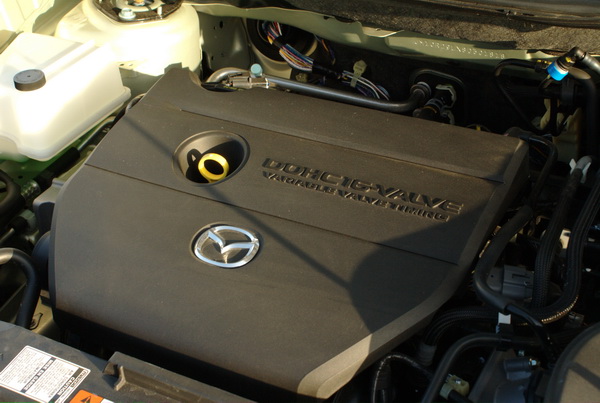
Our Touring edition test car came with an optional 5-speed automatic transmission with overdrive, which does a decent job of keeping the engine in the right gear. Take her into the mountains and things get a bit harried, with the transmission jumping between gears a lot to find an illusive sweet spot. Fortunately there is a manual shift option that allows you to hold the car in gear.
Like other Mazdas, where the MAZDA5 really shines is in the handling department. Despite looking like a somewhat tall, boxy wagon, the MAZDA5 sits low to the ground and drives like the sporty compact that its chassis is based on. Suspension tuning is outstanding, with a nice balance between handling and comfort. There is some body roll, but hang on to the wheel and you are rewarded with a surprising amount of cornering grip. Credit must also go to the low-profile Toyo Proxes all season tires, which provide sure footing without any noticeable drop in ride quality.
Build
Build quality on the MAZDA5 is a notch lower than the best, even at the entry-level end of the spectrum. Some of the knobs and switches feel flimsy to the touch, and there is some unevenness in the exterior body panel gaps. Yet, cruising on the freeway produced nary a creek or rattle and road noise is pleasantly low. Safety features include a full complement of air bags, including side-impact air curtains, and anti-lock brakes with electronic brake assistance, but neither traction or stability control is available.
2009 Toyota Venza Points To New Direction for Sporty SUVs
 Derek
Derek 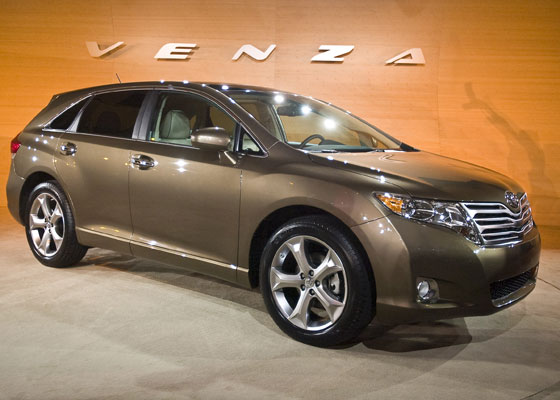
Overly ambitious SUVs were the über-cool family transportation choices for the 90's. Now that we are becoming more socially responsible by choosing right-size vehicles that have a smaller carbon footprint, wagons with the dynamics of a sports sedan and the utility of an SUV are filling the growing demand and are popular choice for young, small families. The difficult decision for young families has always been giving up the sporty lifestyle and trading it in for a lumbering SUV, wagon or minivan. Now there is a new generation of vehicles, such as the VW Jetta Sportwagen, BMW 3-series and 5-series Sport Wagons, and upcoming Audi Q5, filling the crossover category with vehicles that emphasize sport over utility. (Video of the all-new Toyota Venza below the jump)
"The all-new Venza was developed as a vehicle that combines the styling, comfort and fun-to-drive performance elements of a five-passenger sedan with the surprising utility of an SUV," said Bob Carter, Toyota Division group vice president and general manager. "This winning combination will be ideal for active ‘boomers' and young couples with small families."
The development focus of the Venza design team was to create a new crossover vehicle that shifted away from the more traditional SUV styling themes that tend to dominate the segment. Toyota's Calty designers leaned more heavily on a sleek sedan concept with a wide stance that featured a sporty exterior and premium comfort interior but would also be equipped with important SUV attributes such as cargo space, towing capability and all-wheel-drive performance.
Available in front-and all-wheel drive, Venza will be powered by a choice of engines – a V6 or an all-new four-cylinder. Both engines will be mated to a six-speed automatic transmission. Twenty-inch wheels will only be available on V6 models. The 2009 Toyota Venza is scheduled to go on sale later this year.
2009 Honda Pilot Review - Honda’s 8-passenger SUV
By Holly R.

Pros:
- LOVE the white dials/background on the instrument panel
- Really decent acceleration
- Comfortable front seats and the lumbar support is really NICE
- XM® Satellite Radio
- Built-in Bluetooth®
Cons:
- Square shape is great for making more inside storage, but bad for aerodynamics
- Gas mileage is not stellar (made worse with the square-er shape)
- Voice recognition (I am starting to hate these) system
- 3rd row seats are only usable by children or very short people (at 5′6″, I wouldn’t be comfortable for any length of time sitting back there)
Fuel Economy:
Advertised: 16 in the city, and 22 highway (or 18 combined for the AWD Touring Edition).
Introduction:
Wow, the Pilot is ginormous! Okay, I know that’s not really a word, but holy cow! There is a whole lotta vehicle with the re-designed Pilot. It seems that for 2009, the Honda Element got more rounded shapes, while the Pilot got the more square shape - they completely traded places! The new Pilot appears to be significantly larger than it’s older counterparts, and the frontal view is now markedly bolder-looking with its unique grill (bad to the bone). The day-time running lights prevent having to figure out how to turn on the headlights as daylight begins to disappear. I think this really adds to the safety factor, even in broad daylight.
Driving Impressions:
The Pilot accelerated really well. I didn’t try to blast through any corners, as I was having some issues with the aerodynamics of the car. It felt a bit top-heavy, and definitely took a bit of road to get it stopped. Other than that, it was pretty fun to drive. I had a bit of trouble parking, as it’s pretty large! Add to that, one of the other reviewers had put their trailer-hitch mounted bike-rack on the back, so not only was I fighting a larger vehicle than I’m used to, but I had about 3 extra feet behind me to deal with! I reverted to a 16-year old, trying to parallel park for the first time. But it was one of those things that you could get used to, if you spent more than 3 days in a car. Due to the size of the car, I could easily see well up the road. The Pilot weighs a good deal, so that, coupled with being able to see so far ahead (well, and Honda’s safety reputation), I felt pretty darned safe. A definite bonus in my book.
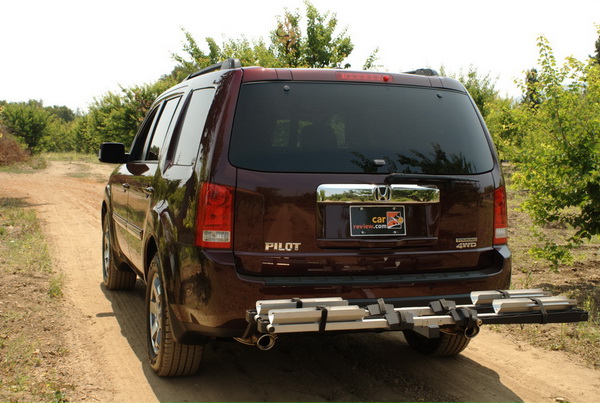
Build:
The Pilot felt super solid. You could take it off-road and not be concerned at all about how it would take the conditions. The doors were solid without being heavy. The interior felt solid enough that you could bang stuff around without damaging the vehicle. We had a couple of stationary trainers in the back, behind the 3rd row seats, that were banging around a few times during an hour drive to a bike race. There wasn’t a mark one on the tailgate area, and nothing fell out when we opened the hatchback. The seats fold forward and back into place without struggle and seem like they would last a very long time. The hidden compartments in the passenger cabin are all well-built and you’d not have to worry about them breaking easily.
Interior Comfort and Ergonomics:
The good:
Tons of interior storage for people who like to carry around lots of stuff. Numerous bottle holders for those who need lots and lots of hydration. Even a little storage compartment in the 3rd row seats (sort of like a 3rd row glove-box). All compartments are tucked away out of sight, and easy to open when you need them. Have to love the the hidden sunglass holder, which doubles as a spy mirror for little, fighting passengers in the rear (possibly arguing over which DVD to watch in the rear-passenger DVD player). Okay, this spy mirror could work well for adults too!
Seats are really comfortable, although I spent very little time sitting in the 2nd and 3rd row seats. I cannot tell if they’d be comfortable for more than 5 or 10 minutes. The leather is nice, not too soft, and not too rough. Lots of adjustments for the driver (including an adjustable lumbar support, which was a really nice feature), and quite a few adjustments for the passenger. And all of the rear seats were easily folded flat, or back into the upright position. 3rd row entry was a breeze, with a quick tug of a lever from the 2nd row seat.
Cabin temperature was easy to control, and I actually got cold a couple of times with the A/C. Dual cabin controls are nice for someone like myself (who melts easily), whilst not freezing out my passenger.
Very easy to read the instrument panel in both broad daylight and approaching darkness (I really liked the white background for the instrument panel).
Given it’s size, I didn’t have any trouble seeing behind or beside me in traffic (when driving forward). I never once had a “oh crap!” moment in it (with the exception of parking). That actually surprised me. Hats off to Honda for making such a large vehicle with few, if any, blind spots!
And lest I forget to mention… I love the automatic lift gate. A push of the button, and up it goes. Another push of the button, and down it goes. In addition, the glass hatch can be opened and closed separately, just in case you only need to reach in. There’s a built-in netting to hold small items that are easily reachable via the glass hatch entry. You need to put larger things in the very back? Not an issue. The netting easily tucks away and allows larger objects behind the 3rd row seats.
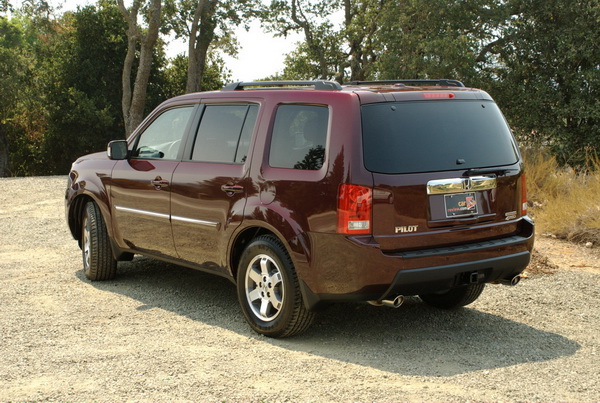
There are so many other interior options that are great (rear passenger DVD player, wireless headphones, USB Audio interface, Bluetooth® Hands Free Link, XM® Satellite Radio, Premium Audio System, Navigation system…) that I could just go on and on and on. This vehicle is LOADED and with really NICE features.
The bad:
I really don’t like the gear-knob on the dashboard. There must be a lot of people who DO love it, because Honda keeps putting it there (CR-V and Pilot in my experience). It does clean up the center area a bit though. Honestly, this was the worst thing that I found wrong with the Pilot, and it’s minor.
Performance:
The 250-horsepower engine definitely got up and moved. And it had a lot of vehicle to move! At around 4,600 pounds, the Pilot is no flyweight vehicle. The weight explains its reluctance to stop on a dime, but it would be something you’d need to allow for in stop and go driving conditions.
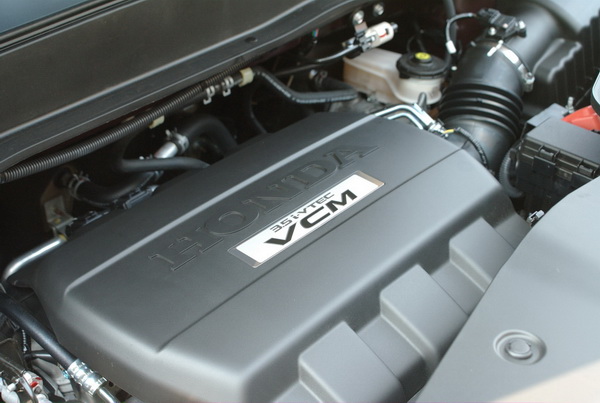
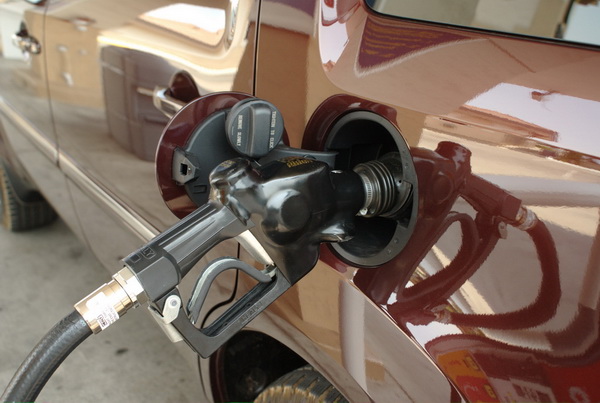
Given the rising fuel costs, I was just a bit disappointed in the mileage. If the edges were slightly rounded, without sacrificing the added space, it would help with the vehicle aerodynamics and fuel usage. Also, because the vehicle was so new (we were among the first to drive it), it was still breaking in. I imagine that if it had a bit more mileage on it, I could have gotten better mileage, especially if I were to drive it over a longer period of time.
Given the above, I really have no other qualms about the Pilot’s performance. It was a steady drive. Accelerated easily. Got me from point A to point B quite comfortably. I felt like it was a solid vehicle that I could count on to get me up to speed and keep me safe, all while carrying a bundle of stuff and passengers, with room to spare.
Handling:
While I wasn’t crazy about how the Pilot handled in a cross-wind, everything else about it screamed: STABLE and SAFE. I should note that while I got blown about a bit in a strong crosswind, I never felt as though we were out of control. I just needed to hang on to the steering wheel and pay close attention. It behaved nicely in stop and go traffic conditions. It was equally at ease doing 75 mph on the open freeway. Uphill driving? Not a problem. It zoomed uphill and on the flats with ease. Curvy roads? Bring it on. Rolling around town looking for a parking place? It drove nicely in “parking space hunt mode”. While the Pilot certainly isn’t a sports car - the turning radius was reasonable (as expected) given it’s size.
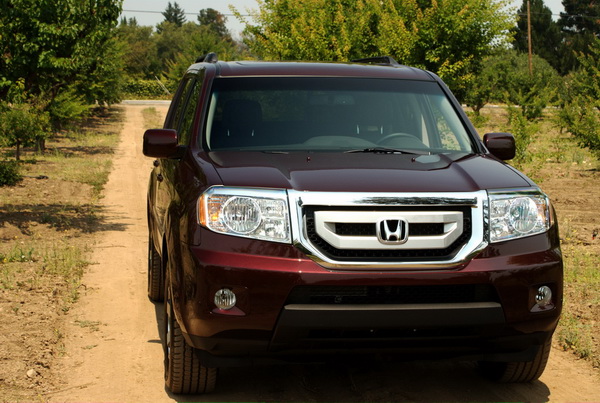
Styling:
Even though
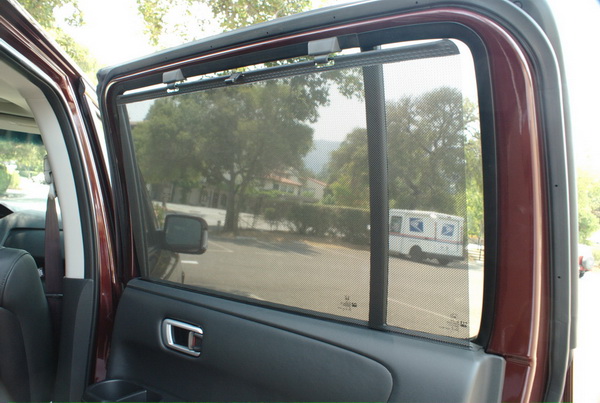
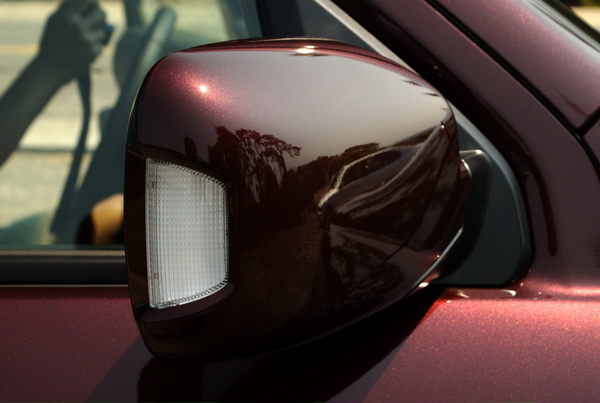
Value:
Overall, the Pilot is not a cheap
All that being said, the experience I had with the Pilot Touring edition, it’s safety record, it’s ease of drivability and the Honda name: I think it’s worth it.
Conclusion:
The Pilot is a solid, well-performing SUV. The 2009 model has been re-designed, and while it’s squarer shaped than previous years, it looks a lot more bad-*ss. It’s comfortable, spacious, easy to see out of, and the features that came with it are very useful for drivers and passengers as well. It appeared truck-like, without actually driving like one, which is a pretty great accomplishment.
|
| Build | Interior | Performance | Handling | Styling | Value | Overall |
| Rating | 4.5 | 4.5 | 4.5 | 4.5 | 4.75 | 4.5 | 4.5 |







